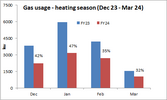Interesting discussion, I would have thought boiler and radiator size is related to recovery speed rather than heat loss? I am no heating engineer, only an electrical engineer, but what I want to do is only heat a room as and when required, and I would like to do that in less than an hour.
What can be debated is how many rooms need to be re-heated at the same time, with a 2 up 2 down likely ½ the house, but with 14 rooms, likely a lot less. But having a 20 kW boiler will not re-heat a room any faster to a 10 kW boiler if the radiator can only deliver 8 kW, simple maths. So for a 20 kW boiler likely we need 60 kW of radiators to actually be able to re-heat areas of the home using the maximum boiler output.
With my old oil boiler easy, I can hear it start/stop, and know when running it produces 20 kW, but this was not so cut and dried with my mothers house, as the boiler could modulate. I did look for some thing to tell me the output, but could not find any meter or other device which would show me what at any point of time the output was, so when running it was some where between 8 kW and 28 kW which is a huge variation.
In the main we lived in the living room, hence the name, and we did not need to heat other rooms, but the living room radiator was less than 8 kW, so to heat one room the boiler would need to cycle. If we also heated the kitchen and hall then the boiler could modulate.
I had no trust in the installers, as they fitted a power shower on a combi boiler, which breaks the local laws, and used a wall thermostat which used a mark/space ratio to stop hysteresis, which would stop the boiler modulating as it should. And failed to put a TRV in the hall, so impossible to get fast recovery when front door opened, without it also turning off the wall thermostat before rest of house warm. Simply fitting a TRV in hall transformed the homes heating. (Once set up)
I would have thought the one pipe system is ideally suited to fan assisted radiators, where there is no restriction to flow through the radiators, but using TRV's the pipe lagging and radiator by-pass pipe size becomes critical, I remember at school how the rooms on the return leg were always cold, clearly rooms near the supply side will recover first, but back in the 50's no pipes were lagged.
I know at work it does not seem to matter if close to boiler (engine) or the last carriage, they all get warm once steam is allowed to flow through the heaters, that is clearly a real one pipe system, and a real boiler, i.e. it produces steam, and last carriage the steam is allowed to exist into the atmosphere giving a really good ambiance with all carriages surrounded with steam, but this one pipe system is clearly not what is referred to with domestic heating.
So
Assume first radiator takes 80 degree system water.
No the first radiator would be 130ºC of steam, super heated, this can be seen as steam not visible until cooled to 100ºC. But I am being pedantic however all this heat loss calculation is pointless, as it is recovery time which is important.


